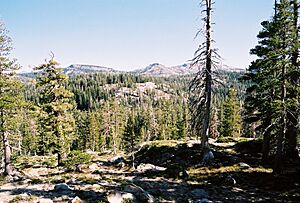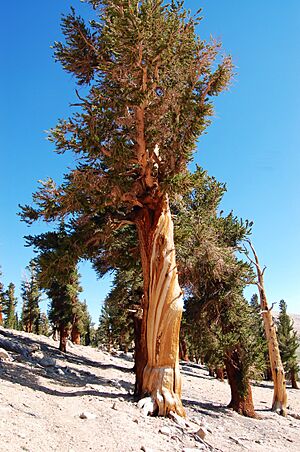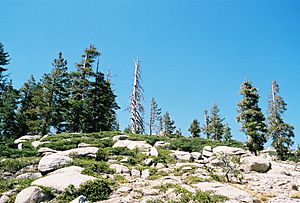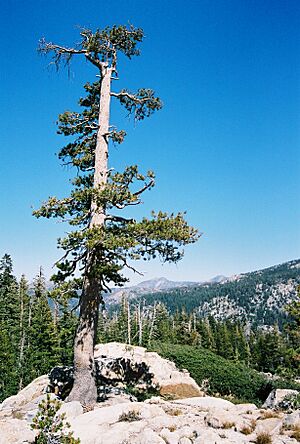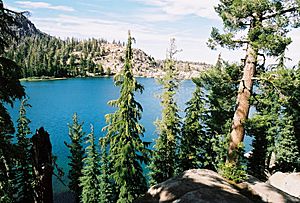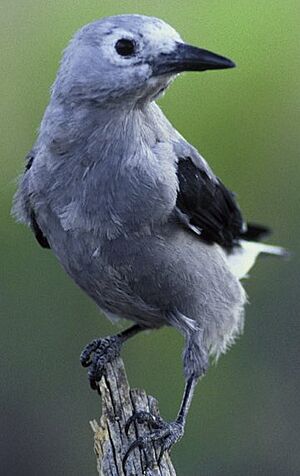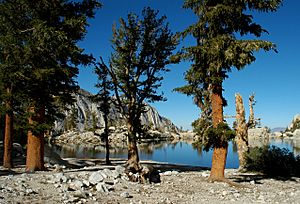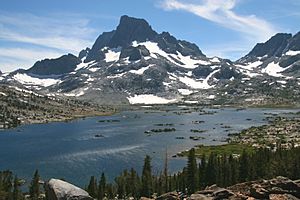Sierra Nevada subalpine zone facts for kids
The Sierra Nevada subalpine zone is a special natural area found just below the treeline in the Sierra Nevada mountains of California, United States. It sits between the upper montane zone (like where red fir forests grow) and the very top of the mountains where trees can no longer grow.
This subalpine zone is usually found at elevations between 8,000 and 12,000 feet (2,450 to 3,660 meters). It's known for its open forests with several types of cone-bearing trees (conifers). These include whitebark pine, lodgepole pine, western white pine, mountain hemlock, and Sierra juniper. The plants and animals here are shaped by the tough weather, which includes lots of snow and strong winds. Also, the soil is thin and doesn't have many nutrients. Because of these hard conditions, plants grow slowly and don't get very tall. The challenging environment also helps different species work together, a process called mutualism.
Since conditions are so difficult, the Sierra Nevada subalpine zone is very sensitive to environmental changes. This includes things like climate change and pollution. Because the trees here live for a very long time, this zone is a great place to study how these changes affect nature.
Contents
Where is the Subalpine Zone?
The subalpine zone in the Sierra Nevada mountains is found at different heights depending on where you are. In the southern part of the range, it's usually between 9,500 and 12,000 feet (2,900 to 3,660 meters). Further north, it's a bit lower, from 8,000 to 10,000 feet (2,450 to 3,100 meters).
Since the southern Sierra Nevada has higher mountains, most of the subalpine zone is in the central and southern areas, south of Lake Tahoe. You might find a few small patches in the northern part of the range on mountain peaks that are taller than 8,000 feet (2,400 meters).
Weather and Environment
The subalpine areas have very long winters and short growing seasons, which only last about 6 to 9 weeks. Even during the summer, temperatures stay cool, and it can even freeze any month of the year.
Most of the rain and snow, about 30 to 50 inches (750 to 1,250 millimeters) each year, falls as snow in winter. In January, temperatures average between 11.5°F and 34.7°F (-11.5°C to 1.5°C). In July, they average between 41.9°F and 67.1°F (5.5°C to 19.5°C). The average temperature for the whole year is about 39°F (4°C). Snow can often be deeper than 10 feet (3 meters), but it's usually about 6.5 feet (2 meters) deep by the end of March.
Strong winds blow all year round. These winds are a big reason why plants don't grow very well near the top of the subalpine zone, close to the treeline. Wind harms plants in two main ways:
- It physically hits them with blowing snow and ice.
- It increases how much water plants lose (called evapotranspiration) in an environment that already doesn't have much water.
The soils here are thin, rocky, and don't have many nutrients. This is because of the cold climate and many glaciation events (when glaciers covered the land) that happened long ago. The soil usually holds a lot of moisture because of the granite rock underneath, and it can get very wet early in the growing season. However, since there's very little rain in the summer, the soil can dry out quickly once the snow melts. This limits how much plants can grow and reproduce later in the summer.
Compared to subalpine zones in the Cascade Range, the Sierra Nevada subalpine gets less yearly rain and has a longer dry summer. But the temperatures are similar throughout the year. Compared to the Rocky Mountains subalpine zone, the Sierra Nevada subalpine has milder temperatures and more yearly rain, with more snow in winter and less rain in summer.
Plants of the Subalpine Zone
How Plants Look and Grow
Generally, the Sierra Nevada subalpine is mostly open woodland. This means that between 30% and 60% of the ground is covered by tree tops. If more than 60% is covered, it's called a forest. However, some trees, especially in protected spots with deeper soil and less wind, can form dense, closed forests.
The way trees grow also changes. Large, single-trunk trees are more common at lower elevations and in protected areas. But closer to the treeline, you'll find more trees with many stems that are short and twisted. This twisted form is called krummholz. There are also areas with mostly herbs and shrubs, but these make up a small part of the subalpine zone. Meadows can appear where there is more water.
Types of Plants
Shrubs and herbs are usually spread out, but they can be common in places where the snow melts earlier in the growing season. There are usually fewer types of herbs in the subalpine zone compared to lower areas like the upper and lower montane zones.
The types of trees in the Sierra Nevada subalpine vary, and there's a good mix of species for a subalpine area. For example, subalpine forests in the Rocky Mountains are usually dominated by just one type of tree. But in the Sierra, forests can have a mix of up to five different tree species, or they can be pure stands of one type, depending on where the species grow and the specific conditions of the microsite (a very small habitat).
Whitebark pine (Pinus albicauls) is probably the most common tree in the central and northern Sierra Nevada subalpine woodlands. This tree grows at higher elevations than any other species in this region. It forms thick, twisted (krummholz) stands near the treeline and on mountain ridges. At lower elevations, whitebark pine can grow with lodgepole pine, Sierra juniper (Juniperus occidentalis ssp. australis), and mountain hemlock (Tsuga mertensiana).
Lodgepole pine (Pinus contorta ssp. murrayana) is very common in the upper montane zone. In the subalpine woodland, it's mostly found growing with other trees, especially whitebark pine. Lodgepole pine usually doesn't grow near the treeline, though sometimes it can also form krummholz.
Western white pine (Pinus monticola) can be found in pure groups, especially on open slopes where snow melts faster. More often, though, western white pine grows mixed with lodgepole, mountain hemlock, Jeffrey pine (Pinus jeffreyi), and/or red fir (Abies magnifica).
Mountain hemlock might be the most common tree in the subalpine zone, especially in the central and northern Sierra. This tree forms thick, pure stands on protected slopes with moist soil. But it can also grow with Sierra juniper and whitebark pine. Mountain hemlock often has two ways of growing on the same tree: one upright trunk and several branches that spread out along the ground. Near the treeline, it often grows like a thick hedge.
Sierra juniper is not very common in the subalpine zone. It only grows on open, rocky slopes, usually among large granite rocks. Limber pine (Pinus flexilis) grows in pure groups on poor, often steep soils along the east side of the Sierra. It forms flat, mat-like krummholz at the treeline. Foxtail pine (Pinus balfouriana) grows on shallow soils on open slopes. It's found in mixed groups at lower elevations and in pure groups closer to the treeline. This tree does not form krummholz and can be found as single-trunk trees even at very high elevations. Foxtail pine is only found in the southern Sierra, where it forms pure stands in areas where whitebark pine would be found further north.
Besides these trees, Jeffrey pine and red fir, which are more common in the upper montane zone, can also be found in small numbers in the subalpine zone. This is especially true on open slopes where snow doesn't stay as long.
How Plants Adapt to Tough Conditions
The way subalpine plants look and work shows how they've adapted to their tough environment. Their leaves live a very long time because they are expensive for the plant to make, and the soil usually doesn't have many nutrients. Since plants get nutrients like nitrogen from the soil to make parts like leaves, this adaptation helps them in subalpine soils because they keep their nutrients better. Also, evergreen plants can do photosynthesis on warm days during the winter. This is a big help in a climate with a very short growing season.
Most perennial herbs (plants that live for more than two years) in subalpine areas have very large roots compared to their shoots (the parts above ground). Or they have big underground stems called rhizomes. These allow them to store carbohydrates underground during winter and grow very quickly during the short growing season. Shrubs tend to grow low to the ground. This shape is good because temperatures near the ground are a bit warmer during the day, which helps with photosynthesis. Also, plants are less exposed to wind when they are close to the ground.
Unlike alpine ecosystems, which don't have a long enough growing season for annual plants (which live only one year) or short-lived perennial plants, subalpine ecosystems often have these types of plants. This is especially true on south-facing slopes. Annual plants that grow in the subalpine are usually quite small and grow very fast.
The most common adaptation of subalpine plants is their ability to do their life processes at very cold temperatures. Without this ability, the growing season wouldn't be long enough to support life. A side effect of this is slow growth, even when conditions are good. This might be a main reason why subalpine zones have a lower limit. Because subalpine trees grow so slowly, trees that grow faster, like red fir, outcompete them at lower elevations. However, slow growth itself can be an adaptation in very harsh environments, as it leads to individuals that live for a very long time. Many of the tree species in the Sierra Nevada subalpine can live over 500 years. Whitebark pine has been found to live as long as 800 years. Foxtail pine, which is related to bristlecone pine (Pinus longaevis), has been estimated to live 2,500 to 3,000 years! It's hard for new seedlings to grow in the harsh subalpine environment, so nature has favored long-lived trees that can reproduce for tens or hundreds of years.
How Species Interact
The tough conditions in the subalpine zone mean that plants don't compete with each other very much. In fact, in stressful environments, positive interactions where species help each other (called mutualism) are often favored. For example, lichens, which are a partnership between fungi and algae or cyanobacteria, are common in subalpine and alpine areas. The way subalpine plants grow in clumps is also partly because they help each other. Individuals benefit by having neighbors that reduce the effects of strong wind and cold temperatures.
There's a special partnership between the Clark's nutcracker bird and two types of pine trees in the subalpine zone. Most pine trees have flat, winged seeds that are spread by the wind. However, whitebark pine and limber pine both have seeds that are not winged and are fleshy. These seeds have likely evolved together with Clark's nutcrackers. These birds use the seeds as a main food source and bury them in the soil or in cracks in rocks. Like most animals that store food, the nutcrackers bury more seeds than they can ever find and eat. So, many of the seeds can sprout when conditions are right. In the subalpine, this way of spreading seeds is very helpful because the seeds are immediately protected from strong winds and cold temperatures, making them more likely to grow.
Environmental Concerns
Climate Change Effects
Because the Sierra Nevada subalpine is in such harsh conditions, almost at the limit of where trees can grow, this ecosystem is very sensitive to changes in climate. The long lives of subalpine species and their distance from human cities make subalpine ecosystems a good place to study climate change.
The exact height of the treeline in a subalpine area has probably moved up and down throughout the Sierra's history. However, some climate changes happening now in the subalpine seem to be new and unusual. Studies have shown that whitebark pine and lodgepole pine grew more quickly in all age groups over a 30-year period starting around 1960. Other researchers noticed that whitebark pine grew more and western white pine moved into snowy areas faster during the 20th century, especially since 1980. Recent studies also showed that subalpine conifers are growing faster now than at any other time in the last 1,000 years.
It's still not clear exactly how subalpine ecosystems will react to a warmer climate. One idea is that plant communities will move higher up the mountains. If this happens, it would likely mean losing a lot of the subalpine zone that exists today. Since subalpine is the highest zone on many mountain peaks, if it moves higher, the zone itself will shrink. In a way, species will be pushed off the mountain. A report by the California Energy Commission and the California Environmental Protection Agency looked at how three different warming situations might affect different plant types in California over 80–100 years. They found that alpine and subalpine plants could be reduced by about 50-80% of their current total area.
Pollution Issues
Few studies have looked at pollution in the Sierra Nevada subalpine. However, the tree species there might be sensitive to certain air pollutants. One study from the subalpine in the European Alps showed higher levels of nitrogen pollution in the air at some places. Jeffrey and ponderosa pine trees in the Sierra Nevada can be harmed by ozone pollution, but mostly at lower elevations. However, another study from the European Alps showed that a native subalpine conifer was sensitive to ozone pollution.
Other Environmental Concerns
Because subalpine areas are isolated and not used much by people, they are relatively free from damage caused by recreation. The harsh climate also makes these areas strong against new species moving in and diseases. Most non-native plants in California are currently found only at low elevations, though some might be able to reach the subalpine. If climate change does make subalpine regions warmer, conditions there might become more suitable for threats like invasive species and diseases.


